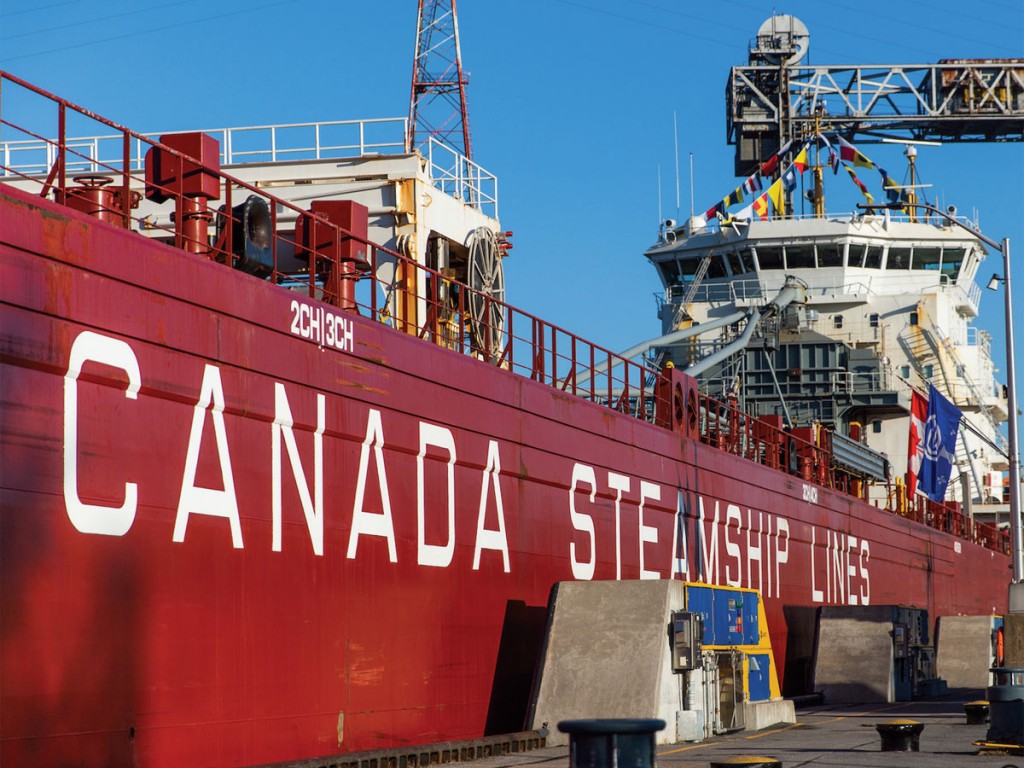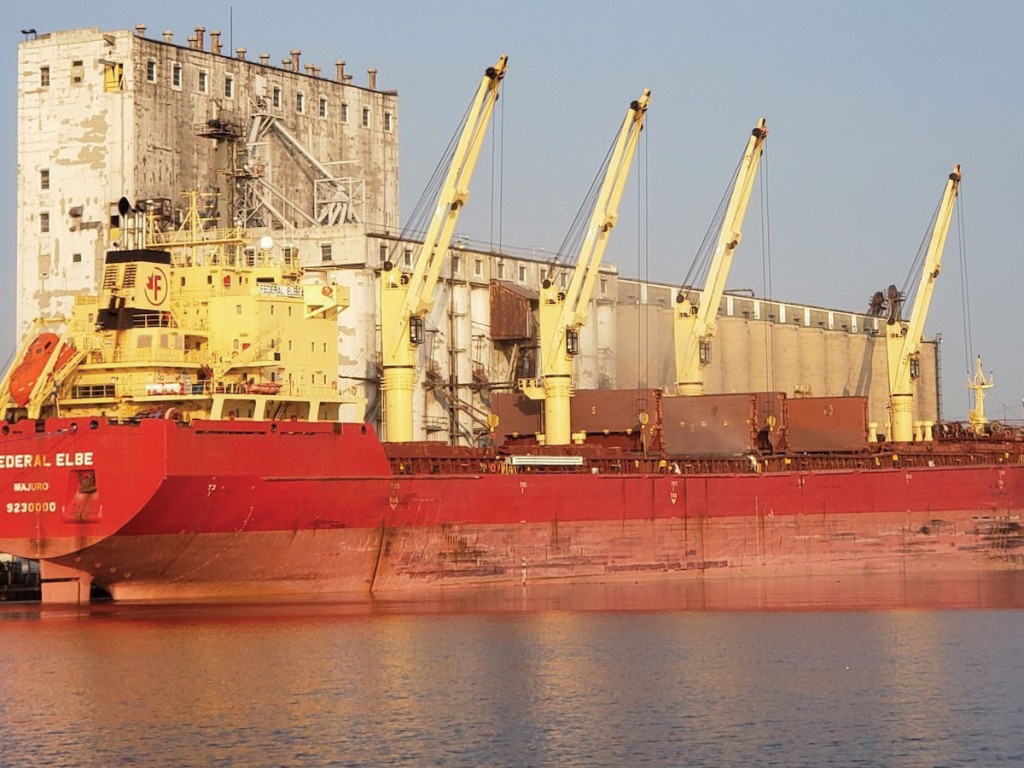Great Lakes prospects looking “great” for 2021 season

The 2021 season on the St. Lawrence Seaway/Great Lakes maritime corridor is barely two months old, but the overall outlook has been encouraging for ports and shipping lines closely involved in the waterway linking the Atlantic Ocean to the industrial heartland of North America.
Indeed, when commercial navigation opened in late March, various stakeholders were cautiously optimistic over bouncing back from what turned out to be relatively small pandemic-impacted decline in 2020.
Thanks to a big increase in grain shipments, total cargo had dropped by under 2% to 38 million metric tons last year. And this year, a target of 40 million tons looks reachable, industry analysts consider, as a recovery gains traction in key regions of the world economy, including North America, Europe and Asia.
Indeed, on the heels of last year’s bumper harvests, grain shipments were robust early in the season. So was the iron ore trade through U.S. Great Lakes ports showing strength while wind farm component shipments via the Seaway were expected to remain substantial.
“Moving goods by water through the Seaway ensures trade is flowing freely between the U.S. and Canada while also reducing emissions,” said U.S. Secretary of Transportation Pete Buttigieg, who participated in the virtual opening ceremony at the St. Lambert Lock near Montreal.
“After 62 years of operation, the binational Seaway System remains a model of international cooperation and partnership and showcases how we can work together to address the challenges of climate change,” he added.
“The Seaway’s consistently high level of system availability contributes to a robust, competitive Great Lakes – St. Lawrence Seaway transportation route,” declared Terence Bowles, President and Chief Executive Officer of the St. Lawrence Seaway Management Corporation. “We provide convenient access to an impressive number of industries, ports, highway and rail networks.”
“Commercial navigation on the Great Lakes St. Lawrence Seaway System is an economic foundation of the U.S. and Canadian economies,” underlined Craig H. Middlebrook, Deputy Administrator of the U.S. Great Lakes St. Lawrence Seaway Development Corporation.
According to the Cleveland-based Lake Carriers Association, which represents the U.S.-flag Great Lakes fleet, iron ore shipments on the Great Lakes totaled 5.6 million tons in April, an increase of over 8% from last year.
Year-to-date, the iron ore trade stood at 9.5 million tons, an increase of 15% compared to the same point last year. This was also 10% above the five-year average for four months of the year. Ports posting big gains were Duluth (MN), Superior (WI), Two Harbours (MN) and Presque Isle (MI).
For its part, the limestone trade year-to-date stood at 2.5 million ton, an increase of 10%, with shipments from Canadian ports rising by 112% whereas they declined moderately from U.S. ports.
Port Milwaukee’s Iimpressive Performance During COVID-19
Among U.S. Great Lakes ports, Port Milwaukee had a noteworthy performance in 2020, especially overcoming pandemic and flooding challenges. It finished the year with its highest annual cargo volume in the past seven years. Overall tonnage for the municipal port and the adjacent private docks in Milwaukee Harbor increased by more than 5% to 2.8 million metric tons – led by agricultural exports and handling of cement.
“Port Milwaukee’s resilience was on full display in 2020,” commented Port Director Adam Tindall-Schlicht. “We overcame flooding resulting from unusually high water levels on Lake Michigan at the start of the year. We also overcame the pandemic’s sustained effect on the economy and on the Port’s essential operations.”
In addition, last year brought Port Milwaukee its largest new investments in decades. The Delong Co. announced its plan to build a $31 million Agricultural Marine Export Facility, and Michels Corp. signed a new lease to expand its marine construction operation.
New infrastructure is part of a diversification strategy adjusting to the port’s historical decline from coal cargo.
Asked by the American Journal of Transportation how he viewed prospective trends in 2021, Mr. Tindall-Schlicht replied: “While Port Milwaukee had its best commercial performance in over 7 years in 2020, challenges remain in 2021 as markets supported by the Port Milwaukee supply chain remain under economic duress. Port Milwaukee’s focus in 2021 is sustaining its traditional customer base as the economic recovery continues.”

Duluth Showing Bounceback
At the Port of Duluth-Superior, the biggest U.S. maritime gateway on the Great Lakes, shipments in 2021 have been off to an encouraging start following a weak 2020 when total volume plunged to 25.8 million short tons – the lowest since 1938.
Each of the port’s major cargo categories experienced declines, most notably iron ore (down 22%) and coal (down 33.2%) as the pandemic stifled North American demand and production. The silver lining in 2020 turned out to be wind energy cargo, with Duluth Cargo Connect welcoming 525,000 tons of wind cargo, shattering the previous record of 306,000 tons set in 2019.
Additionally, grain approached 1.4 million tons, slightly above the five-season average. This helped to generate 85 overseas vessel arrivals, equaling the 2020 total.
In the period through April, the port handled about 4.2 million tons, representing a 48% spike over the 2020 pace. Domestic dry bulk shipments, such as coal, iron ore and limestone sparked brisk early season activity. Domestic grain volume also exceeded the 2020 pattern, rising by 18%.
While it’s too early to predict how the full season total will compare to other years, Deb DeLuca, executive director of the Duluth Seaway Port Authority, has described the early months of 2021 as “encouraging” with indications particularly positive for iron ore, limestone and cement.
In another Great Lake port effort to capitalize on increased bulk shipments, the Port of Cleveland is finishing up an $11 million project at its bulk terminal that mixes two types of iron ore before sending it up the Cuyahoga River. The project, which is largely finished, extended the bulk terminal’s ore tunnel by 440 feet The infrastructure project is one of two nearing completion at the Cleveland-Cuyahoga County Port Authority and is expected to bring another million tons a year in cargo to the port.
Meanwhile, on the other side of Lake Superior, the Canadian Port of Thunder Bay similarly saw its 2021 season get off to a solid start, with cargo shipments to end April 20% above the five-year average. Grain continues to account for most of the port’s business, and Keefer Terminal was busy handling structural steel and steel rails destined for western Canada.
For its part, Canada’s largest port complex on the Great Lakes, the Hamilton Oshawa Port Authority (HOPA), closed out the 2020 season on an optimistic note with a busy fourth quarter which it is counting on to spill over into 2021.
HOPA handled close to 10 million metric tons in 2020 – nearly matching 2019 throughput. Lower volumes in steelmaking and petroleum products were offset by strong shows in grain, fertilizer, salt and gypsum.
Current infrastructure investments are aimed at expanding capacity and improving productivity. These include expanding the large facility operated by Federal Marine Terminals (FMT) and enlarging a Fluke Transportation warehouse for distributing a variety of food products.





